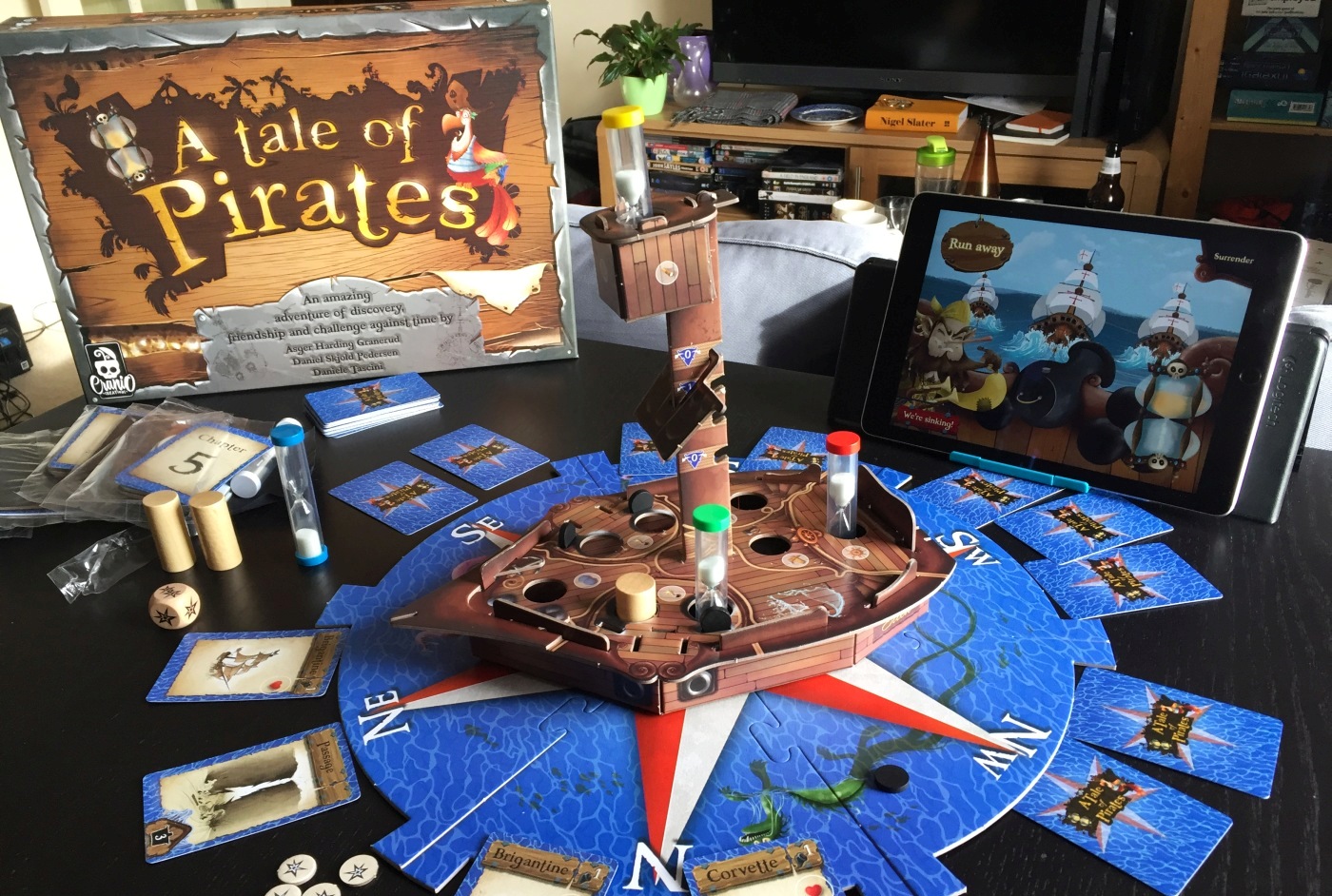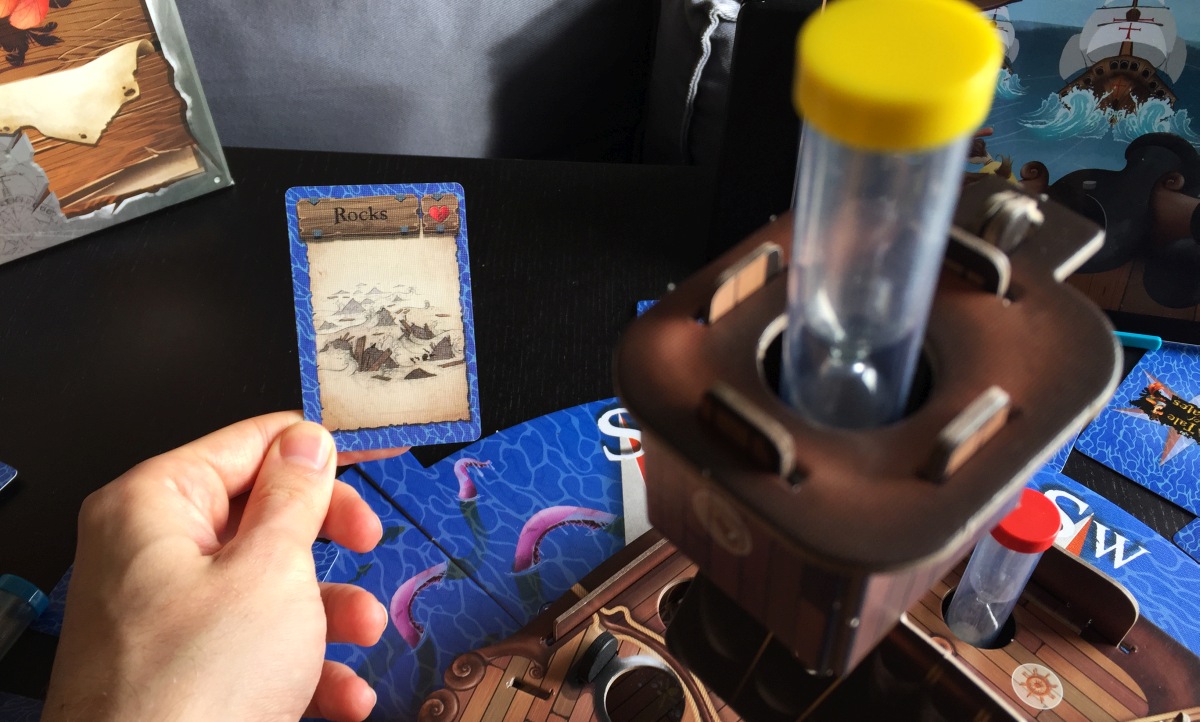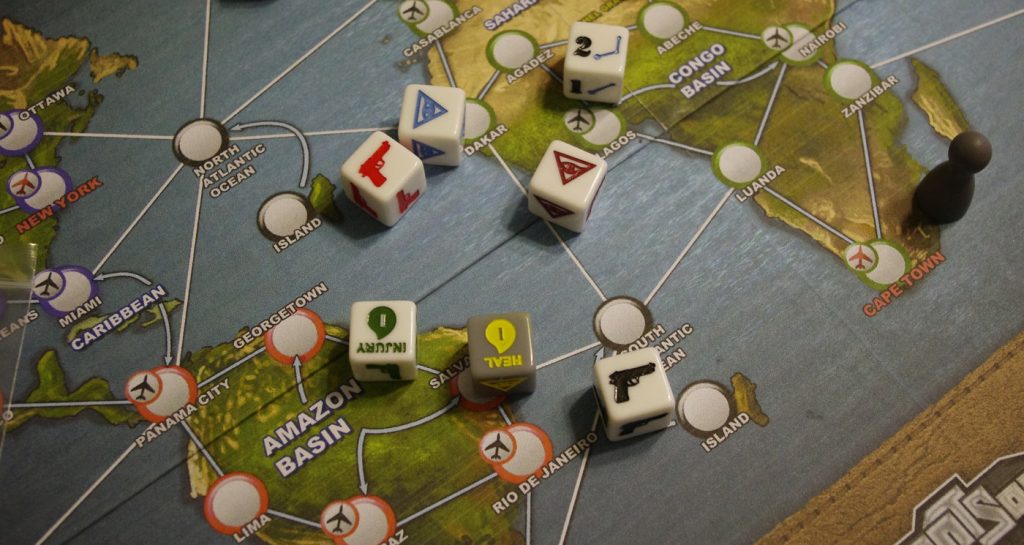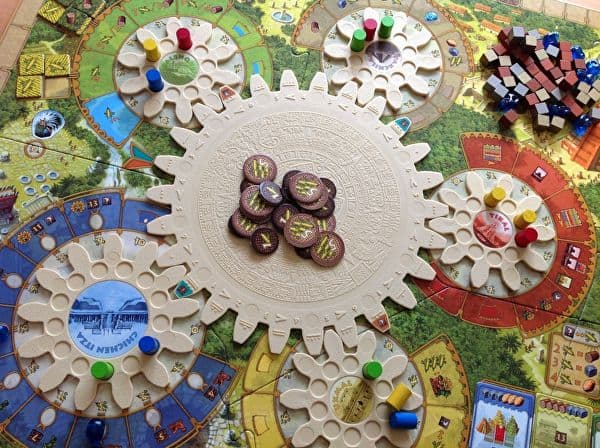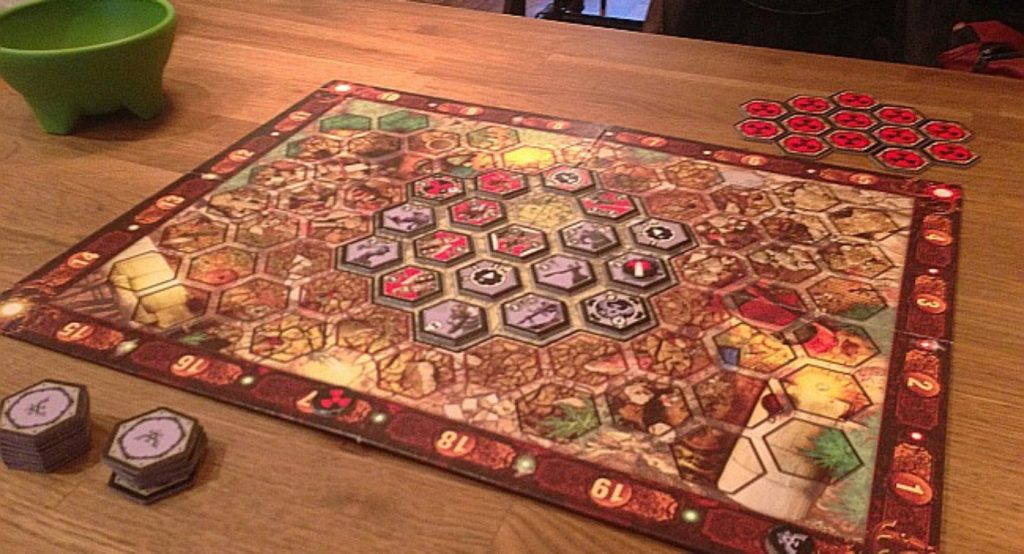Quinns: You’re looking at A Tale of Pirates. More specifically, you’re looking at a 3D pirate ship, a load of sand timers and an accompanying app. And before we get to how all of this fits together, let me add that you’re looking at a great little game.
Last year a lot of people got excited about Kitchen Rush, a real time game where players place sand timers to run a chaotic restaurant together. If Kitchen Rush was any more up our street it’d be banging on our front door, but actually, we found the video game Overcooked to be more entertaining and cheaper.
A Tale of Pirates is similar to Kitchen Rush, but instead of 2-4 players popping their sand timers down to go shopping or cook a bouillabaisse, 2-4 players are placing sand timers to load a cannon or climb the crow’s nest of their very own ship. But more importantly, they’re working together to unlock the next level in a very playful campaign.
The basic game couldn’t be simpler to teach. At the start of each level a deck of cards depicting “things you might encounter on the high seas” is shuffled and dealt in six “directions” around the ship.
Anything your ship is pointing towards is immediately flipped face-up. Perhaps that card is a corvette that’s going to shoot you at the end of the round if you don’t destroy it. Oh no!
Or perhaps you flip the card and it’s rocks, which instantly cause damage to your ship and force you to plug one of the sand timer action spaces with a cork. Unless, of course, you flipped the rocks face-up by taking the action at the top of the crow’s nest, which lets you reveal one card around the ship.
You didn’t crash into those rocks, you spotted them at a safe distance. Good work!
The problem is… well, there are lots of problems.
Being a ship, your cannons point sideways, so if you want to shoot someone you’ve found you have to spin back around by taking the action at the ship’s wheel and physically picking up and rotating the cardboard model of the ship. The height of your sails also determines how far you spin, so if another player dropped the sails (perhaps so you could deal with a passage that needed you be going slowly) you might take the action at the ship’s wheel and find you’re spinning the ship further than intended.
“WHAT ARE YOU DOING?!” shout your friends as you throw all of their plans into disarray. “Sorry!” you cry, like a dithering Captain Jack Sparrow. And it’s awesome.
This nippy ship you’re sailing around has a name, by the way. In the fiction, she’s called Ellen. Who calls a ship Ellen? You might as well call it Steve or Keith.
I’m not going to spoil any of the hazards or components that await in A Tale of Pirates’ ten little mission envelopes. Instead, at the risk of making this game sound less colourful than it is, I’m going to gush like a leaky galleon about how tight it is.
I don’t just mean that every element of play runs smoothly, and the app is a silky thing that manages all sorts of fiddly stuff like mission set-up and unexpected maritime events. I also mean players feel like a tight-knit crew, one that happens to be working in a vessel the size of a small Starbucks.
As I’ve hinted, all of the actions you can take are dependent on one another. On a good mission, this makes the game incredibly satisfying. Imagine us, operating like a bunch of well-oiled pirates, slipping over and past one another ‘neath the Caribbean sun! We all place our sand timers at the same time, and then when the sand runs out, I load the cannon, you fire it, one friend hoists the mainsails and the other rotates the ship. Thud! Bang! Swish! Creak!
But these plans fall apart so easily. Perhaps the app unexpectedly plops your ship in a dead calm. Perhaps Billy spends 30 seconds priming and firing a cannon without a cannonball inside it.
This means the real challenge in A Tale of Pirates is your team quickly settling on a solution when things go wrong. But it’s tricky to prioritise when you’ve got twelve or more cards to deal before the round ends, and it contrasts delightfully with individual players not wanting to waste their sand.
Let’s say in the above example you roll the dreaded “misfire” on the cannon die and instead of sinking our target, you blow up our cannon. Our friends are still ready to spin the ship away to the next card, but players don’t have to do execute their actions until they want to flip their timer and begin a different action. Should our friends sit there like a pair of criminal lemons as we load the cannon and fire it again? What’s the probability we’ll even do enough damage to sink it in one shot? Is our time better spent elsewhere? Also, should someone repair that first cannon by spending 30 seconds in the “Emergency D.I.Y.” space, or will we be fine without it?
But for all of this confusion and silliness, A Tale of Pirates is never stressful. It enjoys the excitement and drama of a real time game, but all of those 30 second waits for sand to run through your timer mean you can relax and enjoy the moment.
It’s an interesting contrast to Kitchen Rush, a far more component-heavy game that also gives each player two sand timers, and constantly wants you to perform. A Tale of Pirates gives you a single sand timer, and once you’ve placed your timer you have the option of studying the board state, or you can take a sip of your beverage, or think about what it’s like to be a squid. You can live your life!
Speaking of which, on “Normal” difficulty you can drift comfortably through the campaign while chasing the prestigious 3 star ratings that app hands out once you finish a level. The “Easy” difficulty is great for young kids, and the “Hell” difficulty is there for groups who want to be tested.
The whole thing is just a real treat. An entertaining and novel challenge with hardly any rules or set-up, letting players focus on enjoying themselves. After we’d played it, I was unsurprised to check online and find the design pedigree behind it- the creators include Asger Granerud, the Danish designer behind the stellar Flamme Rouge, and Daniele Tascini, the Italian designer whose prestigious credits include Tzolk’in and Marco Polo.
But before you part with your precious gold and go scrambling aboard Ellen (gosh, is that name even growing on me?) let me mention a couple of practicalities. You’re likely to finish the campaign in about 5-6 hours total, and while this is an absolutely fantastic game to give away when you’re done with it, do bear in mind you might be ready to give it away after just two or three game nights.
But more importantly, international distribution of A Tale of Pirates is very sketchy at the minute. Be careful you don’t get scalped by online retailers, and be aware that in mainland Europe it retails for around £35. If you don’t want to pay over the odds, put in a pre-order at your friendly local game store.
Alternatively, if you like the sound of piloting a ship in real time but were hoping for something with more complexity and replayability, Space Alert by the legendary Vlaada Chvátil remains a shockingly clever classic that I’d recommend to anyone who likes to be tested. Honestly, that game makes A Tale of Pirates look like a trip around a pond in a pedalo. You have been warned.
I don’t mean that in a bad way, mind you. I love pedalos.
When were you last in a pedalo, readers?

